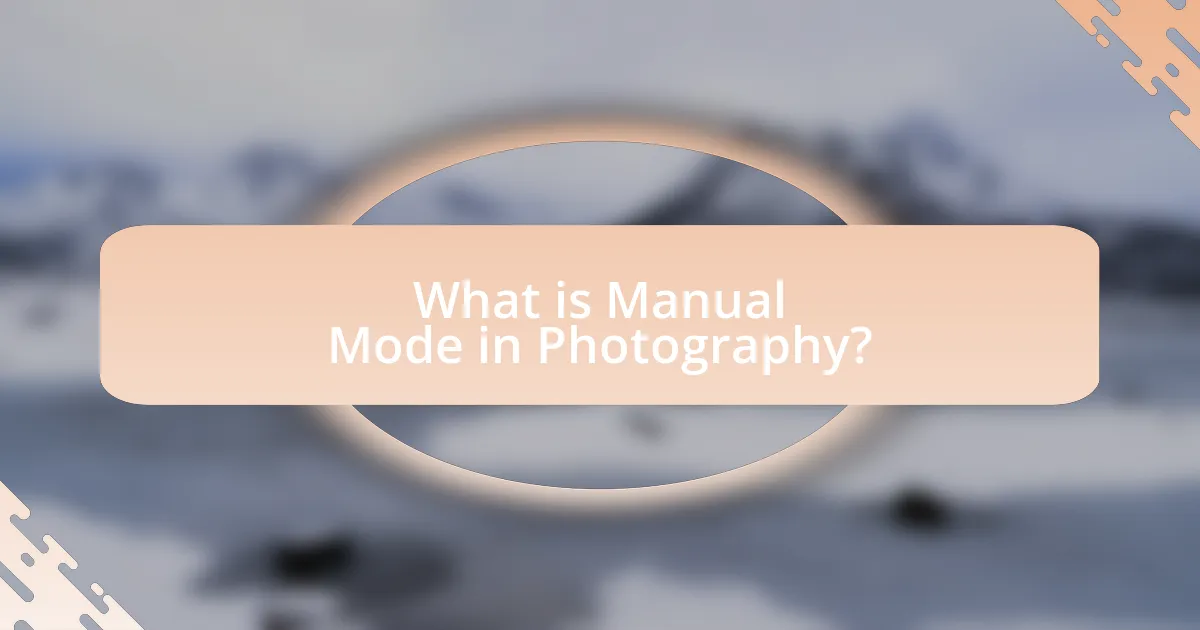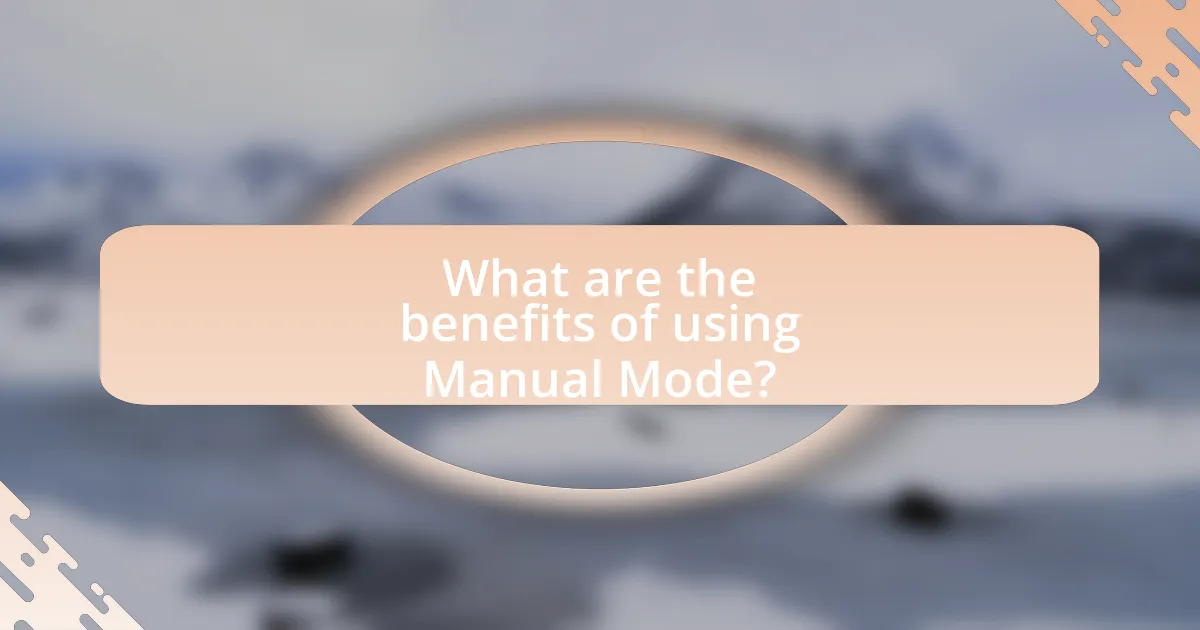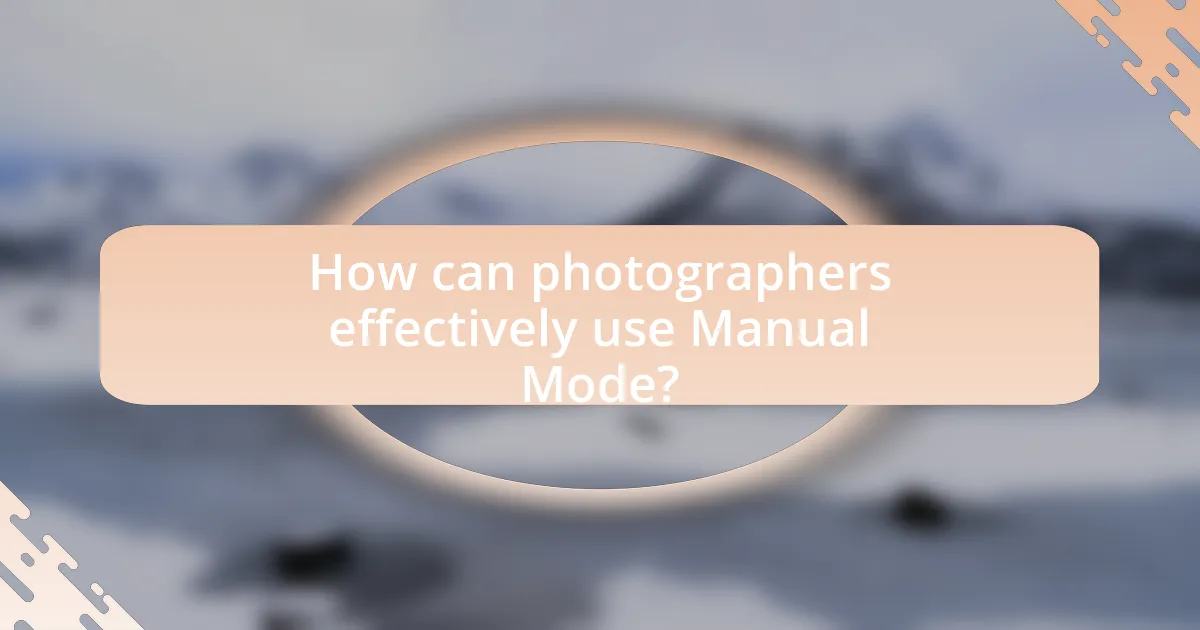Manual mode in photography is a setting that grants photographers complete control over exposure parameters such as aperture, shutter speed, and ISO, enabling precise image capture and creative expression. This article explores the differences between manual and automatic settings, highlighting the importance of manual mode for achieving specific artistic effects and enhancing technical skills. Key components of manual mode, including the interaction of exposure, aperture, and shutter speed, are discussed, along with practical tips for beginners to master these settings. Additionally, the article outlines the benefits of using manual mode in challenging lighting conditions and its role in storytelling through photography, providing resources for further learning and best practices for various scenarios.

What is Manual Mode in Photography?
Manual mode in photography is a setting that allows photographers to have complete control over exposure settings, including aperture, shutter speed, and ISO. This mode enables users to adjust these parameters independently, facilitating creative expression and precise image capture. By utilizing manual mode, photographers can tailor their settings to specific lighting conditions and artistic intentions, resulting in images that reflect their vision. The ability to manipulate these settings is essential for achieving desired effects, such as depth of field and motion blur, which are critical in professional photography.
How does Manual Mode differ from Automatic Settings?
Manual Mode allows photographers to have full control over camera settings such as aperture, shutter speed, and ISO, while Automatic Settings adjust these parameters automatically based on the camera’s assessment of the scene. This difference enables Manual Mode users to creatively manipulate exposure and depth of field, resulting in unique artistic outcomes, whereas Automatic Settings prioritize convenience and ease of use, often leading to less personalized images. The ability to fine-tune settings in Manual Mode is essential for achieving specific visual effects, which is particularly beneficial in complex lighting situations or when a particular mood is desired.
What are the key components of Manual Mode?
The key components of Manual Mode in cameras are shutter speed, aperture, and ISO settings. Shutter speed controls the duration of light exposure to the sensor, affecting motion blur and exposure. Aperture determines the size of the lens opening, influencing depth of field and light intake. ISO adjusts the sensor’s sensitivity to light, impacting image brightness and noise levels. These components work together to give photographers complete control over their images, allowing for creative expression and precise adjustments based on shooting conditions.
How do exposure, aperture, and shutter speed interact in Manual Mode?
Exposure, aperture, and shutter speed interact in Manual Mode by allowing photographers to control the amount of light that reaches the camera sensor, thus influencing the final image. Exposure is the overall brightness of the image, which is determined by the combination of aperture (the size of the lens opening) and shutter speed (the duration the sensor is exposed to light). A larger aperture allows more light in, while a faster shutter speed reduces the time light hits the sensor, balancing the exposure. For example, if a photographer opens the aperture to f/2.8 to let in more light, they may need to increase the shutter speed to 1/500 seconds to prevent overexposure, demonstrating the reciprocal relationship between these settings. This interaction enables creative control over depth of field and motion blur, essential for achieving desired artistic effects in photography.
Why is Manual Mode important for photographers?
Manual Mode is important for photographers because it provides complete control over exposure settings, allowing for creative expression and precise image capture. By adjusting aperture, shutter speed, and ISO independently, photographers can achieve desired effects such as depth of field and motion blur, which are crucial for artistic vision. Studies show that photographers who utilize Manual Mode report higher satisfaction with their images, as it enables them to adapt to varying lighting conditions and achieve specific artistic goals.
How does Manual Mode enhance creative expression?
Manual Mode enhances creative expression by allowing photographers to have complete control over exposure settings, including aperture, shutter speed, and ISO. This level of control enables artists to manipulate light and depth of field, resulting in unique visual effects that align with their artistic vision. For instance, a photographer can create a shallow depth of field to isolate a subject or use long exposure to capture motion blur, both of which are not achievable in automatic modes. By facilitating these creative choices, Manual Mode empowers photographers to express their individual style and intentions more effectively.
What skills can photographers develop by using Manual Mode?
Photographers can develop skills in exposure control, composition, and understanding of camera settings by using Manual Mode. Exposure control involves mastering the relationship between aperture, shutter speed, and ISO, allowing photographers to manipulate light effectively for desired outcomes. Composition skills improve as photographers learn to frame shots intentionally, considering elements like depth of field and focus. Additionally, understanding camera settings enhances technical proficiency, enabling photographers to make informed decisions that align with their creative vision. This hands-on experience fosters a deeper connection with the photographic process, ultimately leading to more impactful imagery.

What are the benefits of using Manual Mode?
Using Manual Mode allows photographers to have complete control over exposure settings, including aperture, shutter speed, and ISO. This control enables the creation of specific artistic effects, such as depth of field manipulation and motion blur, which are not achievable in automatic modes. Additionally, Manual Mode enhances a photographer’s understanding of the relationship between different exposure settings, fostering skill development and creativity. Studies show that photographers who practice in Manual Mode report increased satisfaction with their work and improved technical proficiency.
How does Manual Mode improve technical skills?
Manual Mode improves technical skills by requiring users to understand and manipulate key camera settings such as aperture, shutter speed, and ISO. This hands-on approach fosters a deeper comprehension of exposure and composition, as photographers must make deliberate choices to achieve desired outcomes. Studies indicate that engaging with these settings enhances critical thinking and problem-solving abilities in photography, leading to more informed and creative decisions. For instance, a study published in the Journal of Visual Communication in Medicine highlights that practical experience in manual settings significantly boosts technical proficiency among photographers.
What understanding of camera mechanics does Manual Mode provide?
Manual Mode provides a comprehensive understanding of camera mechanics by allowing photographers to control exposure settings, including aperture, shutter speed, and ISO. This control enables users to manipulate how light interacts with the camera sensor, directly affecting image brightness, depth of field, and motion blur. For instance, adjusting the aperture influences the amount of light entering the lens and the sharpness of the background, while changing the shutter speed can freeze or blur motion. Mastery of these settings enhances a photographer’s ability to achieve desired artistic effects and adapt to varying lighting conditions, reinforcing the importance of understanding the interplay between these elements in photography.
How can Manual Mode help in challenging lighting conditions?
Manual Mode allows photographers to adjust exposure settings, such as aperture, shutter speed, and ISO, to effectively manage challenging lighting conditions. By manually controlling these parameters, photographers can compensate for extreme brightness or darkness, ensuring that images are neither overexposed nor underexposed. For instance, in high-contrast environments, adjusting the aperture can help control depth of field, while modifying shutter speed can freeze motion or create blur, depending on the desired effect. This level of control is crucial for capturing details in shadows and highlights, which automatic settings may overlook, thus enhancing the overall quality of the photograph.
What creative opportunities does Manual Mode offer?
Manual Mode offers photographers the creative opportunity to have full control over exposure settings, including aperture, shutter speed, and ISO. This control allows for the manipulation of depth of field, motion blur, and overall image brightness, enabling unique artistic expressions. For instance, adjusting the aperture can create a shallow depth of field for portrait photography, while varying shutter speed can capture fast motion or create long exposure effects. These capabilities empower photographers to experiment and achieve specific visual outcomes that align with their creative vision.
How can photographers achieve unique effects with Manual Mode?
Photographers can achieve unique effects with Manual Mode by adjusting settings such as shutter speed, aperture, and ISO to create specific visual outcomes. For instance, a slower shutter speed can capture motion blur, while a wider aperture allows for a shallow depth of field, isolating subjects against a blurred background. Additionally, manipulating ISO settings can enhance low-light performance or introduce grain for a vintage look. These adjustments provide photographers with the creative control necessary to produce distinctive images tailored to their artistic vision.
What role does Manual Mode play in storytelling through photography?
Manual Mode plays a crucial role in storytelling through photography by allowing photographers to have complete control over exposure settings, such as aperture, shutter speed, and ISO. This control enables photographers to creatively manipulate light and depth of field, thereby enhancing the narrative quality of their images. For instance, a shallow depth of field can isolate a subject, drawing attention to its emotional significance, while a longer exposure can capture movement, conveying a sense of time and dynamism. By utilizing Manual Mode, photographers can tailor their images to reflect specific moods or themes, ultimately enriching the storytelling aspect of their work.

How can photographers effectively use Manual Mode?
Photographers can effectively use Manual Mode by mastering the three key exposure elements: aperture, shutter speed, and ISO. By adjusting these settings, photographers gain full control over the exposure and creative aspects of their images. For instance, a wider aperture (lower f-stop number) allows more light in, creating a shallow depth of field, which is ideal for portraits. Conversely, a faster shutter speed freezes motion, making it suitable for action shots. Additionally, adjusting the ISO helps manage the camera’s sensitivity to light, allowing for clearer images in low-light conditions. This comprehensive understanding of exposure settings enables photographers to achieve their desired artistic vision, as evidenced by the fact that professional photographers often prefer Manual Mode for its flexibility and creative potential.
What tips can help beginners master Manual Mode?
To master Manual Mode, beginners should focus on understanding the exposure triangle, which consists of aperture, shutter speed, and ISO. Each element plays a crucial role in determining the exposure of an image; for instance, a wider aperture allows more light, while a faster shutter speed can freeze motion. Beginners should practice adjusting these settings in various lighting conditions to see their effects on images. Additionally, using a light meter or the camera’s histogram can help assess exposure accuracy. Regularly experimenting with different settings will build confidence and improve skills in Manual Mode.
How can practicing with Manual Mode lead to better results?
Practicing with Manual Mode can lead to better results by allowing photographers to have full control over exposure settings, including aperture, shutter speed, and ISO. This control enables users to make precise adjustments based on lighting conditions and creative intentions, resulting in images that better reflect their vision. Studies show that photographers who engage with Manual Mode develop a deeper understanding of photographic principles, which enhances their ability to capture high-quality images in various environments. For instance, a study published in the Journal of Visual Communication in Medicine highlights that hands-on experience with manual settings significantly improves technical skills and artistic expression among photographers.
What common mistakes should photographers avoid in Manual Mode?
Photographers should avoid overexposure and underexposure when shooting in Manual Mode. Overexposure occurs when the shutter speed is too slow or the aperture is too wide, leading to loss of detail in highlights. Conversely, underexposure happens when the shutter speed is too fast or the aperture is too narrow, resulting in loss of detail in shadows. Both mistakes can be mitigated by using the camera’s histogram to assess exposure levels accurately, ensuring a balanced image. Additionally, failing to adjust the ISO appropriately can lead to grainy images or unnecessary noise, as higher ISO settings amplify light sensitivity but can degrade image quality. Understanding the exposure triangle—aperture, shutter speed, and ISO—is crucial for achieving optimal results in Manual Mode.
What resources are available for learning Manual Mode?
Resources available for learning Manual Mode include online courses, photography books, and tutorial videos. Websites like Udemy and Skillshare offer structured courses that cover the fundamentals of manual settings in photography. Books such as “Understanding Exposure” by Bryan Peterson provide in-depth knowledge about exposure triangle concepts. Additionally, YouTube channels like Tony & Chelsea Northrup and Jared Polin offer practical demonstrations and tips for using Manual Mode effectively. These resources collectively enhance understanding and application of manual settings in photography.
How can online tutorials and courses enhance understanding of Manual Mode?
Online tutorials and courses enhance understanding of Manual Mode by providing structured, step-by-step guidance that demystifies complex camera settings. These educational resources often include visual aids, practical exercises, and real-world examples that illustrate how to manipulate exposure, aperture, and shutter speed effectively. For instance, a study by the Journal of Visual Communication in Medicine found that interactive learning environments significantly improve retention and comprehension of technical skills. By engaging with these tutorials, learners can practice in a controlled setting, receive immediate feedback, and build confidence in their ability to use Manual Mode creatively and effectively.
What books or guides are recommended for mastering Manual Mode?
“Understanding Exposure: How to Shoot Great Photographs with Any Camera” by Bryan Peterson is highly recommended for mastering Manual Mode. This book provides clear explanations of exposure, aperture, shutter speed, and ISO, which are essential for effective manual shooting. Additionally, “The Digital Photography Book” series by Scott Kelby offers practical tips and techniques for photographers at all levels, focusing on manual settings to enhance creativity. Both resources are widely recognized in the photography community for their straightforward approach and actionable advice, making them valuable for anyone looking to improve their skills in Manual Mode.
What are the best practices for using Manual Mode in different scenarios?
The best practices for using Manual Mode in different scenarios include understanding exposure triangle components—aperture, shutter speed, and ISO—and adjusting them based on lighting conditions. In bright environments, use a faster shutter speed and lower ISO to prevent overexposure, while in low-light situations, a slower shutter speed and higher ISO can help capture more light. Additionally, when shooting moving subjects, prioritize shutter speed to freeze motion, while for portraits, a wider aperture can create a pleasing depth of field. These practices enhance creative control, allowing photographers to achieve desired effects and adapt to varying conditions effectively.